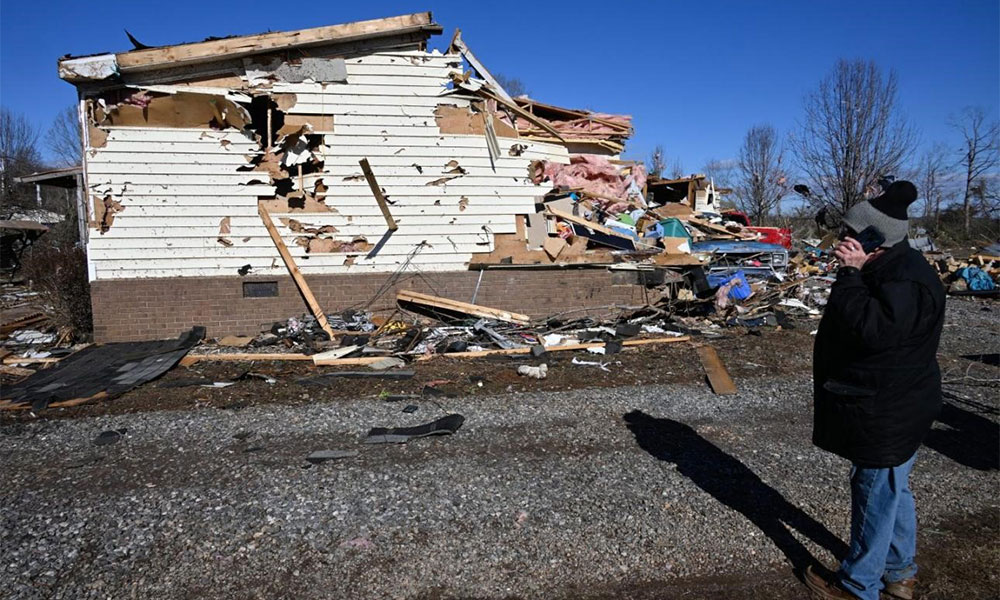
气候风险对于房地产市场而言,是一个价值22万亿美元的严重问题,而且它只会变得越来越严重。Realtor.com最新发布的一份报告,评估了洪水、风灾、野火、高温和空气质量等问题。报告称,美国约44.8%的住宅(价值近22万亿美元)面临“至少一种严重或极端气候风险”。经济学家许佳一(音译:Jiayi Xu)、经济数据经理塞布莉娜·斯培努以及首席经济学家丹尼尔·黑尔等报告作者认为,这代表接近22万亿美元的房屋价值。
此外,还有40.4%的住宅面临严重或极端的高温、风灾和空气质量风险,价值高达19.7万亿美元。许佳一在一份单独的新闻稿中表示:“气候风险非常严重。它可能影响房屋价值、保险成本和房地产市场的整体稳定性。”
许佳一表示,在一些情况下,“在高气候风险和低房价地区,人们不得不忍受这些风险,以获取更经济实惠的住房。”
相对于其他气候或环境相关风险,受到洪水和野火风险威胁的房屋比例较小。高温是重大风险,全美受高温影响的房屋比例最大,约32.5%的房屋面临严重或极端高温风险,这些房屋价值接近13.6万亿美元。在迈阿密,面临“严重或极端风险”的住宅价值最高,其他17个大都市区同样面临风险。报告称,这些面临风险的地区位于佛罗里达州、德克萨斯州、南卡罗莱纳州、路易斯安纳州和弗吉尼亚州。
此外还有风灾或飓风风险,有18.1%的住宅受到影响,价值约7.7万亿美元。而按照总住宅价值计算,迈阿密依旧是风险最严重的地方。受高温风险威胁的州,除了弗吉尼亚州以外,同样面临飓风风险。
虽然空气质量风险似乎很少被作为住宅面临的风险进行讨论,但实际上全美有9%的住宅受到影响(价值约6.6万亿美元)。报告中写道:“旧金山面临严重或极端空气质量风险的住宅总价值最高,而加州和华盛顿州的四个大都市区同样面临严重或极端空气质量风险。”
其次是洪水风险,有约6.6%的住宅面临严重或极端洪水和洪水损失风险。这些住宅的价值约为3.4万亿美元,而且主要集中在迈阿密,该市是“面临严重或极端洪水风险的住宅总价值最高的”城市。但在面临风险的房屋价值占比方面,排在最前列的城市则是新奥尔良。
当然还有野火风险。众所周知,野火是加州的一个严重问题。约5.5%的住宅(价值3万亿美元)面临严重或极端火灾损失风险;约39.1%的“高风险”住宅位于加州,价值1.7万亿美元。而受到威胁的住宅总价值最高的城市是洛杉矶。
许表示,先把房屋损毁和生活受影响等更严重、更可怕的后果放在一边,“问题在于你能否获得经济实惠的保险,以及保险成本会增加多少。”
《财富》杂志此前曾报道过,没有保险的房屋是一个严重问题,可能让因为高房价和高抵押贷款利率已经出现严重可负担性危机的房地产市场进一步恶化。去年,极端天气给美国造成了至少230亿美元损失(有23次严重的气候事件,至少造成10亿美元损失)。一名CoreLogic的高管此前曾对《财富》杂志表示:“很可惜,严重气候事件可能变得更严重,发生频率更高。”加州和佛罗里达州的业主已经有切身体会。加州的业主发现,财产保险公司设定了开出保单的数量上限,或者拒绝提供新保单;而有多家保险公司直接选择离开佛罗里达州。
二月,美国通胀连续第二个月保持较高水平,没有朝着美联储2%的目标进一步下降,这间接意味着抵押贷款利率会在更长时间内保持更高水平。就在上周,美联储主席杰罗姆·鲍威尔在国会听证会上表示,保险成本飙升是通胀维持高水平的主要原因之一。他说道:“过去几年,各种保险,包括房屋保险、汽车保险等,都是通货膨胀的重要来源。”鲍威尔特别提到房地产市场时表示:“从长远来看,保险公司正在停止为一些沿海地区提供保险……这是个严重问题。”(财富中文网)
翻译:刘进龙
审校:汪皓
1月,北卡罗来纳州克莱蒙特,一栋房子被强风摧毁。
气候风险对于房地产市场而言,是一个价值22万亿美元的严重问题,而且它只会变得越来越严重。Realtor.com最新发布的一份报告,评估了洪水、风灾、野火、高温和空气质量等问题。报告称,美国约44.8%的住宅(价值近22万亿美元)面临“至少一种严重或极端气候风险”。经济学家许佳一(音译:Jiayi Xu)、经济数据经理塞布莉娜·斯培努以及首席经济学家丹尼尔·黑尔等报告作者认为,这代表接近22万亿美元的房屋价值。
此外,还有40.4%的住宅面临严重或极端的高温、风灾和空气质量风险,价值高达19.7万亿美元。许佳一在一份单独的新闻稿中表示:“气候风险非常严重。它可能影响房屋价值、保险成本和房地产市场的整体稳定性。”
许佳一表示,在一些情况下,“在高气候风险和低房价地区,人们不得不忍受这些风险,以获取更经济实惠的住房。”
相对于其他气候或环境相关风险,受到洪水和野火风险威胁的房屋比例较小。高温是重大风险,全美受高温影响的房屋比例最大,约32.5%的房屋面临严重或极端高温风险,这些房屋价值接近13.6万亿美元。在迈阿密,面临“严重或极端风险”的住宅价值最高,其他17个大都市区同样面临风险。报告称,这些面临风险的地区位于佛罗里达州、德克萨斯州、南卡罗莱纳州、路易斯安纳州和弗吉尼亚州。
此外还有风灾或飓风风险,有18.1%的住宅受到影响,价值约7.7万亿美元。而按照总住宅价值计算,迈阿密依旧是风险最严重的地方。受高温风险威胁的州,除了弗吉尼亚州以外,同样面临飓风风险。
虽然空气质量风险似乎很少被作为住宅面临的风险进行讨论,但实际上全美有9%的住宅受到影响(价值约6.6万亿美元)。报告中写道:“旧金山面临严重或极端空气质量风险的住宅总价值最高,而加州和华盛顿州的四个大都市区同样面临严重或极端空气质量风险。”
其次是洪水风险,有约6.6%的住宅面临严重或极端洪水和洪水损失风险。这些住宅的价值约为3.4万亿美元,而且主要集中在迈阿密,该市是“面临严重或极端洪水风险的住宅总价值最高的”城市。但在面临风险的房屋价值占比方面,排在最前列的城市则是新奥尔良。
当然还有野火风险。众所周知,野火是加州的一个严重问题。约5.5%的住宅(价值3万亿美元)面临严重或极端火灾损失风险;约39.1%的“高风险”住宅位于加州,价值1.7万亿美元。而受到威胁的住宅总价值最高的城市是洛杉矶。
许表示,先把房屋损毁和生活受影响等更严重、更可怕的后果放在一边,“问题在于你能否获得经济实惠的保险,以及保险成本会增加多少。”
《财富》杂志此前曾报道过,没有保险的房屋是一个严重问题,可能让因为高房价和高抵押贷款利率已经出现严重可负担性危机的房地产市场进一步恶化。去年,极端天气给美国造成了至少230亿美元损失(有23次严重的气候事件,至少造成10亿美元损失)。一名CoreLogic的高管此前曾对《财富》杂志表示:“很可惜,严重气候事件可能变得更严重,发生频率更高。”加州和佛罗里达州的业主已经有切身体会。加州的业主发现,财产保险公司设定了开出保单的数量上限,或者拒绝提供新保单;而有多家保险公司直接选择离开佛罗里达州。
二月,美国通胀连续第二个月保持较高水平,没有朝着美联储2%的目标进一步下降,这间接意味着抵押贷款利率会在更长时间内保持更高水平。就在上周,美联储主席杰罗姆·鲍威尔在国会听证会上表示,保险成本飙升是通胀维持高水平的主要原因之一。他说道:“过去几年,各种保险,包括房屋保险、汽车保险等,都是通货膨胀的重要来源。”鲍威尔特别提到房地产市场时表示:“从长远来看,保险公司正在停止为一些沿海地区提供保险……这是个严重问题。”(财富中文网)
翻译:刘进龙
审校:汪皓
Climate risk is a $22 trillion problem for the housing market—and it’s only set to keep growing. Almost 44.8% of homes across the country, worth nearly $22 trillion, are staring down “at least one type of severe or extreme climate risk,” according to a newly released Realtor.com report which considered flood, wind, wildfire, heat, and air quality issues. That represents nearly $22 trillion of housing wealth, concluded the authors, economist Jiayi Xu, economic data manager Sabrina Speianu, and chief economist Danielle Hale.
More so, 40.4% of homes, worth $19.7 trillion, are at severe or extreme risk when it comes to heat, wind, and air quality. “Climate risk is a big deal,” Xu said in a separate release. “It can impact home values, insurance costs, and the overall stability of a housing market.”
And in some cases, “in areas with high climate risk and lower home prices, people are tolerating these risks in exchange for more affordable housing,” Xu said.
The share of homes threatened by flood and wildfire risk is smaller than any other weather or environment-related risk. Heat risk is the big one, affecting the largest percentage of homes across the country, roughly 32.5%, valued at nearly $13.6 trillion, holding a severe or extreme risk of heat exposure. Miami has the highest value of homes at “severe or extreme risk,” but 17 other metropolitan areas are also at risk. That includes areas in Florida, Texas, South Carolina, Louisiana and Virginia, according to the report.
Then there’s wind, or hurricane risk, which affects around 18.1% of homes worth almost $7.7 trillion. And yet again, Miami faces the most substantial risk, in terms of its total value of homes. The states threatened by hurricane risk are similar to those threatened by the heat, aside from Virginia.
Air quality risk, which doesn’t seem to be discussed much as a threat to homes, can actually impact 9% of homes in the nation (so almost $6.6 trillion). “San Francisco holds the highest total value of homes at severe or extreme air quality risk, whereas four metros from California and Washington are all at severe or extreme air quality risk,” the report reads.
Flood risk comes next, with about 6.6% of homes facing severe or extreme risk of flooding and flood damage. Those homes are worth almost $3.4 trillion, and they’re largely concentrated in Miami, given the city has the “highest total value of homes at severe or extreme risk of floods.” That being said, New Orleans comes up top in terms of the share of property value at risk.
And of course, there’s wildfire risk, which we all know is largely a California problem. Roughly 5.5% of homes, worth $3 trillion, are at severe or extreme risk of fire damage; almost 39.1% of “high-risk” homes are in California; those are worth $1.7 trillion. And the highest total value of homes threatened are in Los Angeles.
Putting to one side the more serious and dire consequences, such as the destruction of homes and peoples’ lives, “the issues are whether you can get access to affordable insurance and how much the costs will increase,” Xu said.
Fortune has previously reported that uninsurable properties are a serious factor further elevating an already seriously unaffordable housing market marked by high home prices and high mortgage rates. Last year, extreme weather cost the country at least $23 billion (there were 23 major weather events that caused at least $1 billion in damage). And “the severity and frequency of major weather events, unfortunately, is likely to go up,” a CoreLogic executive previously told Fortune. California and Florida homeowners have already felt the pain. The former saw property insurers cap the number of policies they write or refuse to write new policies; the latter saw multiple insurers simply flee.
February was also the second month that inflation was “sticky,” refusing to come down further to the Federal Reserve’s 2% target, which indirectly means that mortgage rates will be higher for longer. Just last week, Fed chair Jerome Powell testified to Congress that soaring insurance costs are one of the key reasons that inflation is just, well, sticking around. “Insurance of various different kinds—housing insurance, but also automobile insurance, and things like that—that’s been a significant source of inflation over the last few years,” he said. More specifically, with a focus on housing, Powell said: “In the longer term, companies are withdrawing from writing insurance in some coastal areas…It’s a significant issue.”






